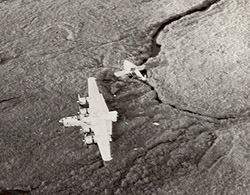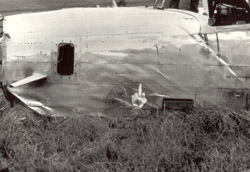
The Atka B-24D Liberator bomber, located at its crash site in Atka Island, Alaska, played a highly significant role in World War II. In the Aleutian Campaign against the Imperial Japanese forces from 1942 to 1943--the only battles fought in North America during the war--it was a superb weapon. This aircraft flew in at least 18 combat missions before finally succumbing to bad weather rather than enemy action. Manufactured in 1941, it is now only one of two B-24Ds known to exist in the world. Designed and built by Consolidated Aircraft, the original appearance of Serial #40-2367 was that of a four-engine bomber with twin tail fins. It weighed approximately 36,000 pounds, had a wingspan of 110 feet and was 67 feet long. It carried a crew of 9 men and was primarily used for bombing. This B-24D airplane came to Alaska in March 1942 and served exclusively in the Aleutian Campaign, but had been taken from combat duty and was being used as a weather observation plane. Had it crashed during combat, the usual pattern of explosion, fire or total loss at sea, would have destroyed it. However, on December 9, 1942 it was crash-landed in Atka, Alaska, in an emergency landing which saved several lives. The tail broke off in the characteristic B-24 manner, but the tail section is intact, minus the vertical tail fins, which are in the vicinity of the aircraft. A brief passage from the 11th Air Force History, 1941-1945, gives the following account:
On 9 December (1942) Colonel Hart and Brigadier General William E. Lynd of General Buckner's staff, took off from Adak in a B-24 piloted by Captain John Andrews. The two officers wished to accompany the weather plane to make personal observations from Kiska and Attu. The plane reached Attu, circled over Holtz Bay, and then returned to Adak. Arriving back at Adak at 1600, the pilot found his base socked in by weather. He notified the tower that he planned to fly to the far end of Atka Island and attempt a crash landing. Atka, too, was closed in, and the plane was crash-landed . . . There was only one casualty. General Lynd sustained a fractured collarbone and the crew members and Colonel Hart spent an uncomfortable night on the beach while the personnel of Eleventh Air Force Headquarters spent an uncomfortable night wondering what had happened to them. The next day, they were signed by a Navy PBY which landed and put a rubber boat ashore. The men had adequate food and were able to gather enough driftwood to build a fire, a difficult problem in the treeless Aleutians. The castaways were picked up on 11 December by the Navy seaplane tender USS Gillis, chilly and tired but otherwise unharmed.

The B-24 was the heavy bomber mainstay, built in larger numbers and in more versions than any other U.S. aircraft during World War II. It served in every theater of the war and was used by all branches of the U.S. Armed Forces, as well as the Air Arms of the British, French, Chinese, Dutch, Australian and Indian Allies. The prototype aircraft was built and first flown on December 29, 1939, after which 18,187 were manufactured. One of the most illustrious chapters in the Liberator's story is its service in the Aleutian Campaign from March 1942 through the end of the war. B-24s flew in the initial patrols and search missions and are best remembered for valiant duties performed during the Kiska and Attu bombing campaign in the summer and fall of 1942 and the re-invasion of 1943. During this time, hazardous long-range missions were flown from Umnak Island in the Aleutians to bomb Japanese installations at Kiska and Attu islands. The concentration of Japanese antiaircraft batteries at Kiska was one of the largest and deadliest in the Pacific.
Visit the National Park Service Travel American Aviation to learn more about Aviation related Historic Sites.
Last updated: October 23, 2021
